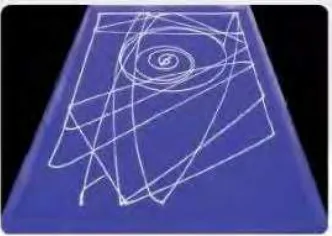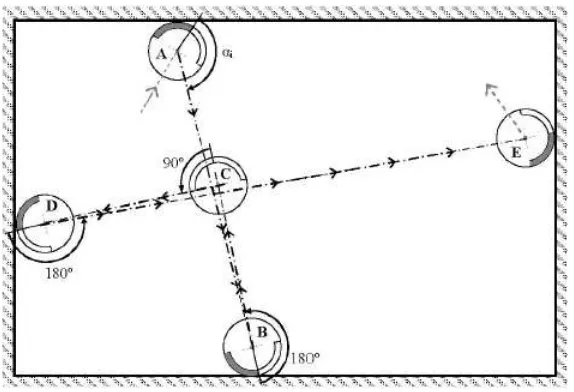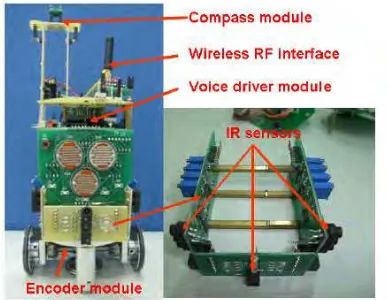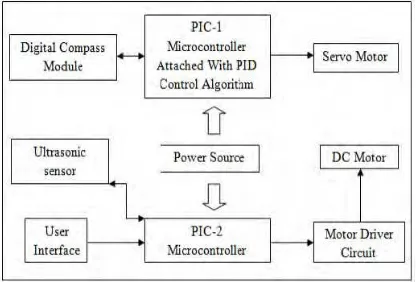ANALYSIS REAL TIME CONTROL OF BEHAVIOR ROBOT IN ASSITING HUMAN IN CLEANING HOUSEHOLD
HEE KEE MING
“ I hereby declare that I have read through this report entitle “ANALYSIS REAL TIME CONTROL OF BEHAVIOR ROBOT IN ASSITING HUMAN IN CLEANING HOUSEHOLD” and found that it has comply the partial fulfillment for awarding the degree of Bachelor of Mechatronic Engineering with Honor”
Signature : ...
Supervisor’s Name : ...
ANALYSIS REAL TIME CONTROL OF BEHAVIOR ROBOT IN ASSITING HUMAN IN CLEANING HOUSEHOLD
HEE KEE MING
A report submitted in partial fulfillment of the requirements for the degree of Bachelor of Mechatronic Engineering with Honor
FACULTY OF ELECTRICAL ENGINEERING UNIVERSITY TEKNIKAL MALAYSIA MELAKA
I declare that this report entitle “ANALYSIS REAL TIME CONTROL OF BEHAVIOR ROBOT IN ASSITING HUMAN IN CLEANING HOUSEHOLD” is the result of my own research except as cited in the references. The report has not been accepted for any degree and is not concurrently submitted in candidature of any other degree.
Signature : ...
Name : ...
I
ACKNOWLEDGEMENT
I would like to thanks Universiti Teknikal Malaysia Melaka (UTeM) give me an opportunity to take part in final year project (FYP). FYP give me a platform that able to learn new knowledge. Thank You for the facility that provided by UTeM so that I able to learn or conduct final year project in a suitable environment.
II
ABSTRACT
III
ABSTRAK
IV
TABLE OF CONTENT
CHAPTER TITLE PAGE
ACKNOLEDGEMENT I
ABSTRACT II
ABSTRAK III
TABLE OF CONTENTS IV-VI
LIST OF TABLES VII
LIST OF FIGURES VIII-IX
LIST OF APPENDICES X
1 INTRODUCTION 1
1.1 Introduction 1
1.2 Research Background 1-2
1.3 Motivation 3-4
1.4 Problem Statement 5
1.5 Objectives 6
1.6 Scope 6
2 LITERATURE REVIEW 7
2.1 Introduction 7
2.2 Design of Cleaning Robot in Market 7 2.3 Ideal to Develop Bathroom Cleaning Robot (BCR) 8
2.4 Component Selection 9
2.4.1 Type of Distance Travel Sensor 9-10 2.4.1.1 Digital Compass Sensor 10-12
2.4.1.2 Microcontroller 12-13
V
3 METHODOLOGY 15
3.1 Introduction 15
3.2 Method 15-19
3.3 Flow Chart 20
3.4 Hardware Design 21-23
3.4.1 Weight of Hardware Design 24
3.5 Prototype 24-25
3.5.1 Weight of Hardware Design 26
3.6 Component and Function 27
3.6.1 DC Motor with Encoder 27
3.6.2 Compass Sensor 27
3.6.3 DC Motor 27-28
3.6.4 Arduino Board 28
3.6.5 Motor Driver 28
3.7 Control Algorithm of Bathroom Cleaning Robot 29 3.7.1 Open-Loop System (Method 1) 29 3.7.2 Closed-Loop System (Method 2) 30
3.8 Experiment 1 31
3.8.1 Wheel Move Distance 31
3.9 Experiment 2 31
3.9.1 Digital Compass Sensor 31-33
3.10 Experiment 3 33
3.10.1 Method to Analysis Trajectory Motion 33-34
4 RESULTS AND DISCUSSION 35
4.1 Experiment 1 35
4.2 Experiment 2 36
4.3 Experiment 3 37
4.3.1 Method 1 (Open-Loop System) 38-39
4.3.1.1 Straight Line 40-42
4.3.1.2 Curve 43-45
4.3.1.3 S-Shape 46-48
4.3.2 Method 2 (Closed-Loop System) 49-50
VI
4.3.2.2 Curve 53-54
4.3.2.3 S-Shape 55-56
4.4 Discussion 57
5 CONCLUSION AND RECOMMENDATIONS 58
5.1 Conclusion 58
5.2 Recommendation 59
REFERENCE 60-61
APPENDICES
APPENDIX A 62-75
VII
LIST OF TABLES
TABLE TITLE PAGE
1.1 Cleaning Robot exists in Market 2
3.1 Way to Program Trajectory of Cleaning Robot 15
3.2 Total Weight of Bathroom Cleaning Robot 26
3.3 Types of Shapes 23
4.1 Digital Compass Sensor Rotate 30, 60 and 90 Degree 36
4.2 Three Difference Kind of Trajectory Shape 37
4.3 Error of Number of Step (Straight Line) 41
4.4 Error of Facing Angle (Straight Line) 42
4.5 Error of Number of Step (Curve) 44
4.6 Error of Facing Angle (Curve) 45
4.7 Error of Number of Step (S-Shape) 47
4.8 Error of Facing Angle (S-Shape) 48
4.9 Error of Number of Step (Straight Line) 52
4.10 Error of Number of Step (Curve) 54
4.11 Error of Number of Step (S-Shape) 56
4.12 Mean Error of Number of Step of Encoder 57
VIII
LIST OF FIGURES
FIGURE TITLE PAGE
1.1 Service Robot for Personal/Domestic Use 4
2.1 Random Path Planning 7
2.2 Demonstration for Cleaning Robot. 8
2.3 Path Learning of Cleaning Robot 8
2.4 Example of “cross exploration”. 9
2.5 Robot with Compass Module 10
2.6 Block Diagram of Navigate Trajectory Motion System 11
2.7 Path Tracking Method for Vehicle 11
2.8 General System Block Diagram 11
2.9 Center of Gravity of Robot 12
2.10 Control System of Trajectory Control 13
2.11 Compare Real and Computed Trajectory in Real Time 13
3.1 System Design for Bathroom Cleaning Robot 16
3.2 X-Y Axis Plan 17
3.3 Trigonometry Method 18
3.4 Angular Distance 19
3.5 Flow Chart of Prototype 20
3.6 Prototype Design Drawing 21
3.7 Slot for Broomstick 22
3.8 Front View of Prototype Design 22
3.9 Top View of Prototype Design 23
3.10 Brush Rotate Direction 23
3.11 Prototype of Bathroom Cleaning Robot (BCR) 24
3.12 Main Circuit to Operate Prototype 25
3.13 Circuit Diagram for Motor with Brush 25
3.14 DC Motor with Encoder 27
3.15 Compass Sensor 27
IX
3.17 Arduino Uno 28
3.18 DC Motor Driver 28
3.19 Control Algorithm for Open-Loop System 29
3.20 Control Algorithm for Closed-Loop System 30
3.21 Experiment Prototype 31
3.22 Draw Angle on Paper 32
3.23 Digital Compass Sensor on Paper 32
4.1 Straight Line with Method 1 38
4.2 Curve Line with Method 1 38
4.3 S-Shape with Method 1 38
4.4 Number of Step Value Detected for Every 0.5 Second for 40 Straight Line
4.5 Angle of BCR Face Every 0.5 Second along Straight Line 40 4.6 Number of Step Value Detected for Every 0.5 Second for Curve 43
4.7 Angle of BCR Face Every 0.5 Second Along Curve 43
4.8 Number of Step Value Detected for Every 0.5 Second for S-Shape 46
4.9 Angle of BCR Face Every 0.5 Second Along S-Shape 46
4.10 Straight Line with Method 2 49
4.11 Curve Line with Method 2 49
4.12 S Shape with Method 2 49
4.13 Number of Step Value Detected for Every 0.5 Second for Straight 51 Line
1
CHAPTER 1
INTRODUCTION
1.1 Introduction
Research background, motivation, problem statement, objectives and scope will be present in this chapter.
1.2 Research Background
2
cleaning robot in the market that move randomly. Besides, the sensor that detect surrounding environment will not be include in this project.
Table 1.1: Cleaning Robot exists in Market Road Cleaning Robot
Vacuum Robot
Window Cleaning Robot
Floor Cleaning Robot
3
1.3Motivation
Cleaning is an important task for human to maintain healthy life. Unfortunately, human now are busy working and lack of time to clean their housing environment. To overcome this problem, they need a cleaning robots that able to assist them to conduct household chores. Although market already have many types of cleaning robot for household chores but cleaning robot that designed to clean bathroom still not familiar.
One of the motivation for me to conduct this project is because one of the magazine [1] title “When Will We Have Robots To Help With Household Chores?” from IEEE Spectrum. From the title of the magazine, it show that human are willing to have a cleaning robot that able to reduce their working task to finish their household chores. In this magazine, it mention that big company like Google has recently start buying spree of Robotics Company. It show that cleaning robot become important for the future and it will improve quality of life of human. With the research of big company, it will greatly improve or accelerate robotics technology in the world. This is because big company willing to pay huge amount of money for research.
Another magazine [2] from IEEE Spectrum“So, Where Are My Robot Servants?” mention that the idea of robots doing chores around the house has long captured by people’s imaginations and robot would help them live independently longer and providing care. From both of the magazine, it show that the demand of human on cleaning robot are keep on increasing and many research for household chore robot are in progress.
4
that able to learn to do what they do will be design in this project to reduce time taken to finish chores and user is able to program cleaning robot trajectory motion as they like.
The cleaning robot that fix to clean bathroom is just a prototype, the main focus of this project is the technology that able to program trajectory of cleaning robot as user demonstrate and redo the trajectory. This technology able to include into every cleaning robot if successful.
Figure 1.1: Service Robot for Personal/Domestic Use[3]
5
1.4 Problem Statement
The main function of cleaning robot is to clean the selected area nicely. Cleaning robot should be able to clean the surface that passes by perfectly. Most of the bathroom floor is rough surface to prevent human fall down because of slippery.Therefore, the material of the brush is important enough when clean the surface. Material for brush to clean rough surface should be strong enough to clear the dirt inside slit.
Besides, weight of cleaning robot is also important when design the prototype. The weight of bathroom cleaning robot should be big enough to pull down the body of cleaning robot. This is because when body of cleaning robot is light, surface of brush and floor does not able to contact nicely to clean the floor. Besides, bigger weight will increase the grip between the tires and floor. Tires that have proper grip on the floor is able to prevent cleaning robot move out of desired trajectory. The brushes that rotate to clean surface will also well contact when weight pull down the body of robot.
DC motor with encoder was used to detect the motion of tires and store it into memory. Data that store in memory will be used when bathroom cleaning robot operate. Rotation motion of brush will create unwanted force that will affect BCR does not move in desired trajectory. Compass sensor was used to overcome the problem when desired angle and real-time angle are difference. Compass sensor that use able to record the angle of cleaning robot facing when human demonstrate the trajectory.
The position of digital compass sensor place in body of cleaning robot is important. If the sensor place position not suitable, data that collected is not accurate and bathroom cleaning robot will not face to selected angle. When bathroom cleaning robot faces to difference angle and move, this will increase the path error when cleaning robot redo trajectory that programed. Therefore, position to place digital compass sensor should be test for few times and get the best position to place the sensor.
6
1.5 Objectives
The objectives for this project are:
1. To design a prototype cleaning robot that able to clean bathroom environment.
2. To develop a bathroom cleaning robot that able to learn from human demonstrate trajectory and redo the demonstrate trajectory.
3. To analysis the performance of developed cleaning robot in terms of direction, maneuverings movements and path error.
1.6 Scope
To achieve the objectives that mention, scope for this project was list as below:
1. Material to design prototype will be plastic, rubber and metal that easily get from market.
2. Bathroom cleaning robot (BCR) that design only allows to operate on floor that is flat surface. The BCR does not able to climb up or move to another level when operate.
3. Analysis of cleaning robot will be done in three difference shapes like straight line, round shape and square shapes.
4. Angle that able to detect by digital compass sensor in cleaning robot only in X- Axis and Y-Axis.
7
CHAPTER 2
LITERATURE REVIEW
2.1 Introduction
In this chapter the concept to design learns by demonstrate bathroom cleaning robot will discuss. Besides, theory and component used will be discussed in this chapter.
2.2 Design of Cleaning Robot in Market
There are many cleaning robot for household chores in the market. Unfortunately, most of the cleaning robot are moving in random position and use sensor to detect surrounding to prevent collision. After go though some journal, it show that most of the cleaning robot in market are using collision sensor, infrared sensor, dust sensor, ultrasonic sensor, sonar range sensor, laser ranger finder and acceleration sensor to detect surrounding environment when moving in random[4]. Many types of sensor will be include in the cleaning robot just to prevent cleaning robot stuck or collide of cleaning robot and obstacle. This is because cleaning robot that sell in market is design to clean user house and every house will have difference size and contain obstacle.
8
2.3 Idea to Develop Bathroom Cleaning Robot (BCR)
The general idea to design path learning bathroom cleaning robot (BCR) is based on the journal [7]. It writes about the idea to program robot trajectory follow a person demonstration. Therefore, this project is to design a prototype of BCR to learn human demonstrate trajectory and show the trajectory movement when operate. The way they use to program cleaning robot is using a broomstick to move cleaning robot. Cleaning robot will automatically generated trajectory that demonstrate and matches the trajectory when operate.
This is because cleaning robot that move randomly contain some disadvantages. That is cleaning robot will miss out some part when doing cleaning process[5]. Beside of that, time taken for cleaning robot that moving randomly to finish cleaning process will be longer compare with cleaning robot that able to program trajectory[6]. To reduce the component use to build up a cleaning robot and reduce time taken for cleaning robot finish cleaning process, a bathroom cleaning robot that able to learn from demonstrate trajectory and redo demonstrate trajectory will be create.
Figure 2.2: Demonstration for Cleaning Robot.
9
2.4 Component Selection
2.4.1 Type of Distance Travel Sensor
There are many types of sensor that able to measure travel distance of an object. Sensor like infrared sensor[8], ultrasonic sensor [9], acceleration sensor[10] and encoder [11] that are able to measure the travel distance of robot.
The infrared sensor and ultrasonic sensor are using the concept like detect surrounding and calculate move distance. This kind of sensor is not suitable for difference types of room space. For acceleration sensor, it is able to calculate the distance travel according to the velocity that detected.
Besides, sensor like encoder able to measure travel distance of object according to number of step detected. In journal [11], it mention that encoder was used to estimate the size of the cleaning room. They attach collision detector and encoder on the body of cleaning robot to detect the size of room. They create two environment of room to conduct experiments: with furniture and without any furniture. For experiment in room without furniture, cleaning robot is able to measure the size without any obstacle and get better results. Encoder is able to calculate the horizontal distance and vertical distance of the room according to the value of encoder come out with some mathematical calculation and get the actual size of the room.
10
Data that collected from encoder sensor is much more accurate compare with other infrared sensor, ultrasonic sensor and acceleration sensor that mention at above. This is because encoder is measure the rotation angle on the wheel but infrared sensor, ultrasonic sensor and acceleration sensor is measure distance travel of the robot with mathematical formula. If the position of sensor attach on body of cleaning robot is not suitable, it will affect the results of whole project. Therefore, encoder sensor was selected to measure the travel distance of bathroom cleaning robot.
2.4.1.1 Digital Compass Sensor
When cleaning robot moving, the trajectory maybe does not fully follow demonstrate trajectory did by user. One of the way to tune the position or trajectory of bathroom cleaning robot to follow demonstrate trajectory is using compass sensor that able to modified error that occurs [12]. Compass Sensor able to detect angle of machine face to when user start to demonstrate trajectory until the end. Data that collected will be used to compare with actual angle of bathroom cleaning robot facing when testing prototype. Angle of bathroom cleaning robot will be tune when actual angle and desired angle are difference.
Figure 2.5: Robot with Compass Module
11
[image:24.595.197.421.292.421.2]Figure 2.6: Block Diagram of Navigate Trajectory Motion System
Figure 2.7: Path Tracking Method for Vehicle
Journal that wrote by students from University Malaysia Pahang (UMP) [14] show that compass module is able to track position of robot face. In their journal it is discuss to develop a straight line robot movement by using digital compass module. Although unexpected external force changing the moving path of robot, robot still able to veer back to original set-point direction to achieve smooth and stabilized movement.
[image:24.595.201.410.592.733.2]![Figure 1.1: Service Robot for Personal/Domestic Use[3]](https://thumb-ap.123doks.com/thumbv2/123dok/485243.53259/17.595.136.479.238.464/figure-service-robot-for-personal-domestic-use.webp)



